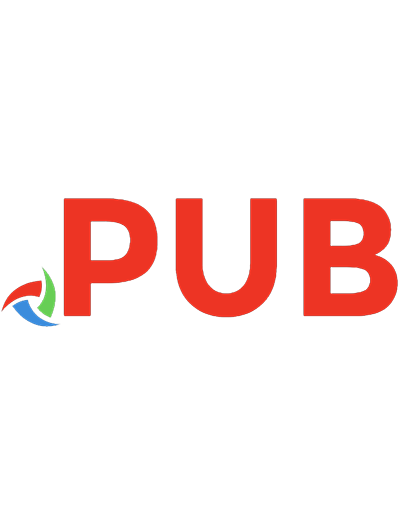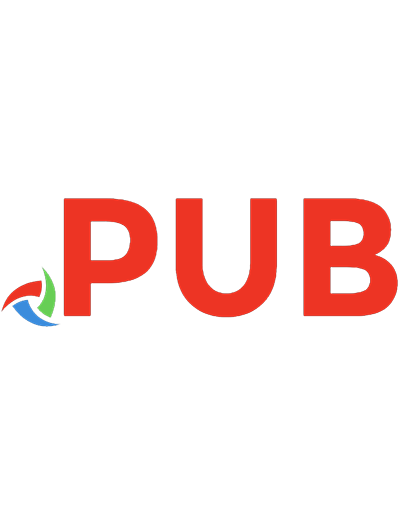Classical Control Systems: : Design and Implementation [1 ed.] 9781783322480, 9781842657492
CLASSICAL CONTROL SYSTEMS: Design and Implementation covering the first course and begins with a presentation of famous
143 87 12MB
English Pages 199 Year 2012
Polecaj historie
Citation preview
Design and Implementation Rohan Munasinghe
9
781842
657492
Munasinghe
ISBN 978-1-84265-749-2
Classical Control Systems Design and Implementation
Design and Implementation
Classical Control Systems: Design and Implementation covering the first course and begins with a presentation of famous historical feedback control systems such as the water clock and flyball speed governor followed by Plant modeling with the use of a RC circuit (electrical) and shock-absorber (mechanical) alongwith feedback control concept using the same two plants. Timedomain and frequency-domain designs are presented using rootlocus and Bode methods with Matlab simulations while PID controller design is discussed with reference to compensators (lead, lag, and notch), controller implementation in analog (using OpAmps) and digital (microcontroller) forms. Illustrations and examples are extensively used to help quick and correct understanding of the subject. The examples are based on Matlab simulations of which the codes are freely available at http://www.ent.mrt.ac.lk/~rohan/books/ pp5221/ index.html. The book has been written concisely so that it could be covered within a single semester conveniently.
Classical Control Systems
Classical Control Systems
Rohan Munasinghe
Rohan Munasinghe
α Alpha Science International Ltd. Oxford, U.K.
Classical Control Systems Design and Implementation 198 pgs. | 111 figs. | 7 tbls.
Rohan Munasinghe Professor Department of Electronic and Telecommunication Engineering University of Moratuwa Moratuwa Copyright © 2012 ALPHA SCIENCE INTERNATIONAL LTD. 7200 The Quorum, Oxford Business Park North Garsington Road, Oxford OX4 2JZ, U.K.
www.alphasci.com All rights reserved. No part of this publication may be reproduced, stored in a retrieval system, or transmitted in any form or by any means, electronic, mechanical, photocopying, recording or otherwise, without prior written permission of the publisher. Printed from the camera-ready copy provided by the Author. ISBN 978-1-84265-749-2 Printed in India
Preface
Rohan Munasinghe
Contents Preface .......................................................................................................... v 1
Historical Inventions of Control Engineering ............................ 1 1.1 250 BC Flow Regulated Water Clock ............................................ 1 1.2 200 BC Self Re-Filling Oil Lamp ................................................... 2 1.3 1st Century AD Weight Regulated Liquid Filling Device ............. 3 1.4 1788 AD Flyball Governor ............................................................. 3 1.5 Summary ........................................................................................ 5
2
Model and Response .......................................................................... 7 2.1 Mechanical System: Shock Absorber ............................................ 7 2.2 Electrical System: RC Circuit ....................................................... 8 2.3 System Response ......................................................................... 10 2.3.1 First Order System (RC Circuit) ..................................... 10 2.3.2 Second Order System: Shock Absorber ........................... 12 2.4 Linearization ................................................................................ 13 2.4.1 Example ............................................................................ 15 2.5 Summary and Conclusion ........................................................... 15
3
Laplace Transforms ......................................................................... 17 3.1 Transformation from t to s .......................................................... 17 3.1.1 Common Laplace Transforms .......................................... 17 3.1.2 Properties of Laplace Transforms ................................... 21 3.2 Application of Laplace Transforms in Control Systems ............. 30 3.2.1 First Order System (RC Circuit) ..................................... 30 3.2.2 Simulation ........................................................................ 31 3.2.3 Second Order System: Shock-Absorber ........................... 33 3.2.4 Simulation ........................................................................ 35 3.2.5 Simulation ........................................................................ 38 3.2.6 Simulation ........................................................................ 43 3.3 Transfer Function ........................................................................ 46 3.3.1 Experimental Determination of Transfer Function ........ 50 3.4 Summary and Conclusion ........................................................... 51
viii
Contents
4
Feedback Control with a Single Feedback Gain ...................... 53 4.1 Effect of Feedback Gain .............................................................. 53 4.1.1 Effect of K on RC Circuit Response ................................. 54 4.1.2 Effect of K on a Height-Adjustable Stabilized Platform . 62 4.1.3 Simulation ........................................................................ 66 4.2 Root Locus Design ....................................................................... 69 4.2.1 Root Locus Rules .............................................................. 70 4.2.2 Example ............................................................................ 75 4.3 Summary ...................................................................................... 82
5
Time-Domain Design of Second Order Feedback Control Systems ............................................................................... 83 5.1 Under-damped Generic Second Order System (0 < ζ < 1) ......... 84 5.2 Desired Response ......................................................................... 88 5.3 Example ....................................................................................... 88 5.4 Summary ...................................................................................... 90
6
Generic Compensators ................................................................... 93 6.1 Lead Compensator (PD control with frequency roll-off) ............ 94 6.1.1 Example ............................................................................ 94 6.1.2 PD Controller with Frequency Roll-off .......................... 102 6.2 Lag Compensator (PI control) ................................................... 102 6.2.1 PI Controller ................................................................... 103 6.3 Notch Compensator ................................................................... 104 6.3.1 Example: Notch Compensator Design ........................... 105 6.4 Summary .................................................................................... 107
7
Frequency-Domain Design of Feedback Systems ................... 111 7.1 Frequency Response .................................................................. 111 7.1.1 Gain and Phase of Common Blocks ............................... 112 7.2 Phase Margin and Gain Margin ................................................ 120 7.3 Example: Controller Design in Frequency Domain ................. 120 7.4 Summary .................................................................................... 133
8
PID Controller for Process Control ........................................... 137 8.1 Proportional Controller ............................................................. 137 8.2 Integral Controller ..................................................................... 138 8.2.1 Example .......................................................................... 139 8.3 Derivative Controller ................................................................. 141 8.4 Tuning PID Controller .............................................................. 141 8.4.1 Ziegler-Nichols Method .................................................. 141 8.5 Cohen-Coon Method .................................................................. 143 8.6 Integral-based Method .............................................................. 143 8.7 Example ..................................................................................... 144 8.8 Summary .................................................................................... 147
Contents
xi
9
Controller Implementation .......................................................... 149 9.1 Controller Canonical Form ........................................................ 149 9.2 Analog Controller Implementation ........................................... 150 9.2.1 Operational Amplifier in Analog Controller Implementation .............................................................. 150 9.2.2 Example: Analog Controller Implementation ............... 156 9.3 Digital Controller Implementation ........................................... 159 9.3.1 Example: Digital Controller Implementation ............... 161 9.4 Summary .................................................................................... 162
A
Coverup Method ............................................................................. 165
B
Integral
C
Laplace Transforms ....................................................................... 169
t
∫e o
−σ t
sin ωtdt ................................................................. 167
D Newton-Raphson Method ............................................................. 171 E
Block Diagram Algebra ................................................................ 173 E.l Closed Loop Transfer Function ................................................. 173 E.2 Cascade Blocks .......................................................................... 174 E.3 Parallel Blocks ........................................................................... 174 E.4 Exercise ...................................................................................... 176 E.4.1 Problem ........................................................................... 176 E.4.2 Solution ........................................................................... 176
F
Time Constant ................................................................................ 177
Bibliography .......................................................................................... 179
List of Figures 1.1 1.2 1.3 1.4 2.1 2.2 2.3 2.4 3.1 3.2 3.3 3.4 3.5 3.6 3.7 3.8 3.9 3.10 3.11 3.12 3.13 3.14 3.15 3.16 3.17
250 BC water clock by Ctesibius of Alexandria, and his level controlled floating valve .................................................................... 200 BC Self re-filling oil lamp by Philon of Byzantium ................... Ist century AD weight regulated liquid filling device by Heron of Alexandria, Egypt .............................................................. Flyball governor ................................................................................
2 3 4 5
(a) Motorcycle shock absorber, and (b) Equivalent damper spring mechanism ................................................................ 8 (a) Shock absorber forces (b), and (c) Free body diagram ................ 9 (a) Simple RC circuit and (b) currents at node A ............................. 9 A nonlinear function f(x1+ x2) ≠ f(x1) + f(x2) does not satisfy the theory of superposition ................................... 14 Delta function .................................................................................. 18 Unit step .......................................................................................... 18 (a) f(t) (b) its time delayed version f (t – T) ..................................... 22 Construction of a pulse using delayed steps .................................. 24 Two ways of performing the double integration ............................ 26 Exogenous input r(τ) and its response y(t)
![Operating Systems Design and Implementation [3 ed.]
0131429388, 9780131429383](https://dokumen.pub/img/200x200/operating-systems-design-and-implementation-3nbsped-0131429388-9780131429383.jpg)


![Control Systems: Principles and Design [Third edition]
9780070668799, 0070668795](https://dokumen.pub/img/200x200/control-systems-principles-and-design-third-edition-9780070668799-0070668795.jpg)






![Classical Control Systems: : Design and Implementation [1 ed.]
9781783322480, 9781842657492](https://dokumen.pub/img/200x200/classical-control-systems-design-and-implementation-1nbsped-9781783322480-9781842657492.jpg)